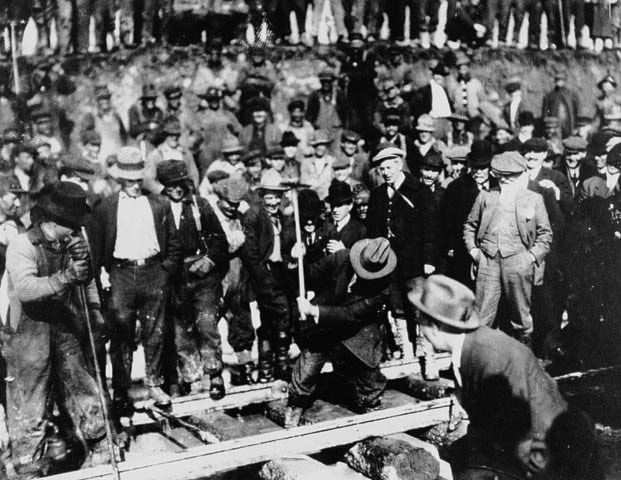The Grand Trunk Pacific Railroad celebrated its centennial last Monday, with an anniversary tour and commemorative train ride.
Its creation marked the starting point of the modern-day Bulkley Valley.
Construction began on the 833-mile track from Prince George to Prince Rupert in 1912 and was completed in just less than two years.
“The arrival of the GTP signalled a crucial moment for the opening up and subsequent development of the northern interior,” UNBC history professor Jonathan Swainger said.
“Not only did it provide a vital line to outside markets, it established a string of non-native settlements that, in many ways determined the future population profile for the region.”
But one of those settlements, the town of Smithers, almost never came into existence.
The initial plan for the railway bypassed the Bulkley Valley entirely, going through the Telkwa Pass and on to Terrace. That would have cut some 130 kilometres off the present route.
But then-B.C. Premier Richard McBride argued that, though a route through the Bulkley Valley and Hazelton would be longer, it would better serve communities and would be located closer to agricultural land and mineral deposits.
Once the route was finalized, Grand Trunk executives set about finding a place for a switching station and divisional headquarters.
Their first choice was the town of Hubert, but they ran into problems when land speculators bought up all the surrounding area and tried to sell it back to the Grand Trunk at exorbitant prices. The railroad company refused the speculators’ demands and set their sights on another location.
They then looked westward to Aldermere, just outside of Telkwa. But the Aldermere Board of Trade wasn’t too keen.
They called a meeting and drafted a letter to serve to Grand Trunk executives.
An excerpt of the letter from the June 11, 1913 edition of The Interior News (initially called the Telkwa Tribune):
“A large and enthusiastic meeting of the Aldermere Board of Trade was held last week for the purpose of arousing the sentiment of the community to the proposed invasion of a ruthless corporate, the Grand Trunk Pacific, who intend to desecrate the classic groves of Aldermere with a barbarous roundhouse, a malevolent divisional point and a division headquarters.
“The Board of Trade pledges to resist to the utmost the attempts on the part of the GTP to thrust a station down our throats with its accompanying horde of shacks and cons.”
With that response, the Grand Trunk Pacific turned its eyes to a flat swamp, 15 kilometres east of Aldermere – present day Smithers.
“There is no doubt in anyone’s mind that Smithers was a creation of the Grand Trunk Pacific,” historian and author of Smithers, A Railroad Town, Harry Kruisselbrink said.
Once the location was settled, work on the local headquarters and switching station began quickly.
The first surveyors arrived on 29th of April, 1913 and with 30 days the clearing of the townsite was in full swing.
On October 4 of the same year, the first train to Smithers arrived, carrying steel and supplies to continue the excavation and the building of the headquarters.
Advertisements for the new townsite boasted:
“Trains are now running to Smithers. Seizing the opportunity of location in the very heart of one of the largest agricultural and mineral districts in British Columbia, the Grand Trunk Pacific created the new town of Smithers and made its only general freight and passenger division headquarters between Prince Rupert and Prince George, a distance of 400 miles.”
The line was completed the following year, on the morning of April 7, 1914. Two crews working one mile apart built towards each other as quickly as they could to finish their half-mile of track.
The eastern crew arrived at the point of completion minutes before the western crew.
Grand Trunk Railroad president Edson Chamberlain drove the last spike and engineer R.A. Harlow wrote “Point of Competion” on the tracks, forgetting to add the letter ‘L.’
Final costs for the railroad exceeded $93 million (not adjusted for inflation), approximately $120,000 per mile.
The railway eventually bankrupted the Grand Trunk Pacific, forcing the Canadian government to purchase the line when the company defaulted on repayment of construction loans.
The railway was taken over by the Department of Railways and Canals and was eventually placed under the management of a crown corporation. By 1923 it had been completely absorbed into the Canadian National Railway system.
Bankruptcy and nationalization aside, the railway continued to operate and prosper for the next century, providing an economic base for a small town that began as nothing more than a swamp, but became the bustling hub of the Bulkley Valley.
